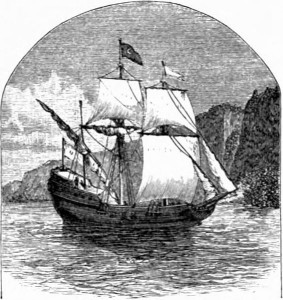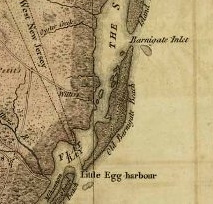“Long Land Water” of the Indians becomes the New Jersey of the British
We shall probably never know the name of the first European to sight the New Jersey shore line and Long Beach. Most historians today credit Henry Hudson with the distinction of having been the first to land.
As will be remembered, he was an Englishman employed by the Dutch East Indies Company. On April 4, 1609, he sailed in search of a Northwest Passage to India. His single ship, the “Half Moon,” was a two-masted vessel of about eighty tons, manned by a crew of twenty.
Hudson sighted Newfoundland, then coasted down the shore, landing near the present Portland, Maine. He then rounded Cape Cod and sailed southward as far as the Virginia Capes. There he turned about and entered the Delaware Bay on August 28, 1609. Unable to locate deep water to his liking, and fearing the shoals, he again put to sea and sailed up the New Jersey coast.
It is said he anchored off Barnegat Inlet for the night of September 2, 1609. The next day he dropped anchor at Sandy Hook in four and one-half fathoms of water and twelve hundred feet from the beach.
A landing was made on Friday, September 4, 1609. Accounts of this event differ. Some claim that Hudson first sent a small boat manned by a few of his crew to ascertain whether the Indians were friendly. Others contend that Hudson led the landing party and was the first European to step ashore on the soil of New Jersey.
Hudson remained at sandy Hook for eight days during which the first hostile act on the part of the Indians occurred. On Sunday, September 6, 1609, one of the sailors, John Coleman or Colman, a member of a small boat crew, was shot through the neck by an arrow and died. Two other members of the boat party were wounded.
Again accounts differ. Some contend that the small boat was close to shore and that the attacking Indians were hidden in the foliage. Others hold that Hudson was in charge and that his boat was pursued by several canoes carrying a war party of Indians.
In any event John Coleman was killed and buried at the foot of one of the gnarled cedar trees that lined the shores of Sandy Hook for so many years. This was most probably the first encounter between Europeans and American Indians within the limits of the present State of New Jersey.
But many Europeans must have sighted the New Jersey coast line and Long Beach before Henry Hudson. And it is even possible that some of these mariners were shipwrecked on the treacherous shoals.
John Cabot, a Venetian, with his son Sebastian, sailed from Bristol, England in 1497 in the service of Henry VII. From Newfoundland the Cabots sailed down the eastern coast of North America as far as cape Hatteras and possibly as far as Florida. This fact seems to have been ignored by most historians. The Cabots must have sailed along and sighted the New Jersey Coast and Long Beach.
A Florentine, Giovanni Verranzo, commanding a squadron of three vessels for King Francis I of France, sailed along the Atlantic coast of North America. It is known that he sailed into New York Bay in 1523. In the same year a Portuguese, Estevan Gomez, sailing for Emperor Charles V of Portugal, is believed to have done some exploring along the shores of both the Delaware and Hudson Rivers.
It is not only possible but quite probable that the intrepid Norse navigators sailed along this coast as early as 1000 A. D. These men may have landed on the New Jersey shores. Some day we will probably know whether these seamen were the first to discover New Jersey, some hundreds of years before the present accepted dates.
Nova Caesarea – New Jersey
What is now the State of New Jersey had many names in the past. The Indians called it “Skaabee” or “Scheyichbi,” generally translated as “Long Land Water.” The Swedes knew it as “Nye Svierge” or “New Sweden, along with their settlements on the west banks of the Delaware. The Dutch called it “Nova Belgia,” and when included with New York it became “New Netherlands.”
The flags of three monarchic governments flew over what is now New Jersey. That of the Sweden until 1654, when the Dutch took control for ten years. The British then conquered the Dutch and held sway for more than a century.
The British, under Colonel Richard Nicolls, seized “New Netherlands” from the Dutch on August 27, 1664 (O.S.) in the name of the Duke of York. Colonel Nicolls called the land west of the Hudson River, including New Jersey, ‘Albania.”
On June 23 and 24, 1664 (O. S.), James, Duke of York, had granted the land between the Hudson and Delaware Rivers to two royal favorites: John, Lord Berkeley, privy councilor and Baron of Stratton: and Sir George Carteret, who had been treasurer of the Royal Navy.
The land was to be known as “Nova Caesarea” or “New Jersey,” as a compliment to Carteret who had successfully defended the Isle of Jersey in the Puritan Civil War of 1643.
After the land division was agreed upon, Carteret became proprietor of East New Jersey and Lord Berkeley became proprietor of West New Jersey.
Colonel Nicolls, while administering the affairs of New York, had granted licenses to several settlers from the New Haven Colony, in Connecticut, to purchase large tracts of land in northern New Jersey from the Indians.
The settlers from New England came down, took up their lands and proceeded to make their own laws to govern themselves. Finally, in a letter dated November 25, l672, the Duke of York annulled these grants in order to solidify the Colony. However, many North New Jersey settlers who held their lands under grants from colonel Nicolls refused to pay quit-rents to the Proprietors.
After many conflicts with the settlers, the proprietors, in 1702, surrendered the governing powers back to the crown and New Jersey became a Royal colony under the administration of Lord Cornbury, Royal Governor of New York.
The Colony of New Jersey continued to be governed by the Royal Governor of New York until 1738, when, in order to appease a rising resentment, particularly among the farmers, New Jersey was given its own governor.
Lord Berkeley disposed of his portion of New Jersey in 1675. After much discussion, George Keith, Surveyor-General of East Jersey, in 1687, was ordered by the Proprietors to run a dividing line between East and West New Jersey.

 Thomas F. Gordon, in his “History of New Jersey,” published in 1834, refers to Tuckerton in this manner: “post town and port of entry for Little Egg Harbour district, about 35 miles S.E. of Mount Holly, 65 from Trenton, and 189 N.E. from W.C. (Washington, D.C.), situate on a narrow tongue of land, projecting into the marsh of Little Egg Harbour Bay, Little Egg Harbour town-ship, Burlington Co., contains between 30 and 40 dwellings, 4 taverns, 5 stores, 2 Methodist churches, a Quaker meeting house. It lies upon a navigable stream, called Shord’s Mill Branch, 6 miles from the Bay, whence wood scows and flats ascend to the town. There is a large business done here in timber and cord-wood; and salt is, or was manufactured in the vicinity. The town is frequented during the summer by many persons for the benefit of sea-bathing, &c. A stage plies regularly between it and Philadelphia.”
Thomas F. Gordon, in his “History of New Jersey,” published in 1834, refers to Tuckerton in this manner: “post town and port of entry for Little Egg Harbour district, about 35 miles S.E. of Mount Holly, 65 from Trenton, and 189 N.E. from W.C. (Washington, D.C.), situate on a narrow tongue of land, projecting into the marsh of Little Egg Harbour Bay, Little Egg Harbour town-ship, Burlington Co., contains between 30 and 40 dwellings, 4 taverns, 5 stores, 2 Methodist churches, a Quaker meeting house. It lies upon a navigable stream, called Shord’s Mill Branch, 6 miles from the Bay, whence wood scows and flats ascend to the town. There is a large business done here in timber and cord-wood; and salt is, or was manufactured in the vicinity. The town is frequented during the summer by many persons for the benefit of sea-bathing, &c. A stage plies regularly between it and Philadelphia.”